Unit Decomposition
Unsame Inc. began as a self-funded software startup company based in the United States. It is a social system called a business, a phenomenon programmed to several purposes, which can be expressed in terms of the needs (or demands) of the entities it interacts with. As shown in Figure 4.1, the four main purposes of Unsame as a business organization are to create value to shareholders, customers, employees, and society.
Figure 4.1. A startup business organization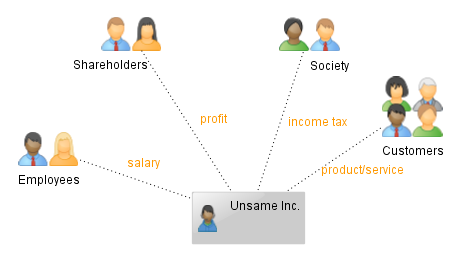
The formula for constructing a purpose statement can be either generic (e.g. create value for shareholders) or specific (e.g. generate profit for shareholders).
Unit Decomposition Using Functional Configuration
After reaching a certain size, Unsame's monolithic organizational structure was no longer matching the demands and the complexity of the environment, which led to job specialization and functional departmentalization. As a result, the CEO Office was able to delegate to the new organization functions not only business operations, but also the majority of its business interactions.
Figure 4.2. Functional Configuration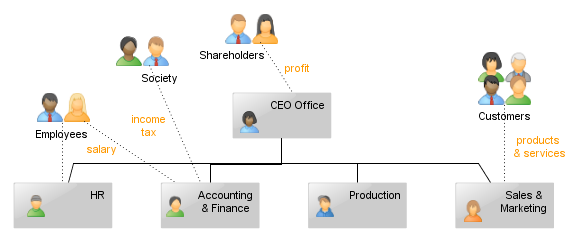
After the reorganization, the CEO Office could focus on relationships with the shareholders as well as the direction, coordination, and control of activities performed by the functional units. From the CEO's perspective, the hypothetical further decomposition of HR, Accounting & Finance, Production, and Sales & Marketing units would remain invisible to the CEO and, therefore, should not increase the complexity of her work.
Unit Decomposition Using Divisional Configuration
In two years, Unsame Inc. decided to expand its operations to France and Japan.
Figure 4.3. An international business organization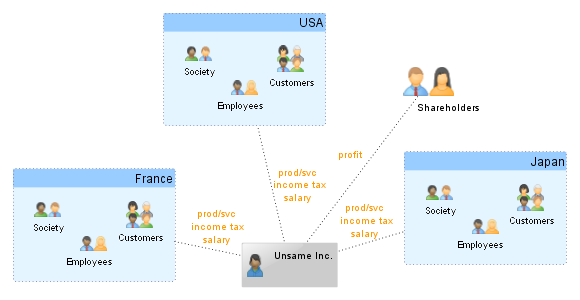
Operating in three environments—each having its own customers, competitors, governments, and regulations—presented a significant challenge to the CEO who decided to transform the company into a divisional organization.
Figure 4.4. Divisional Configuration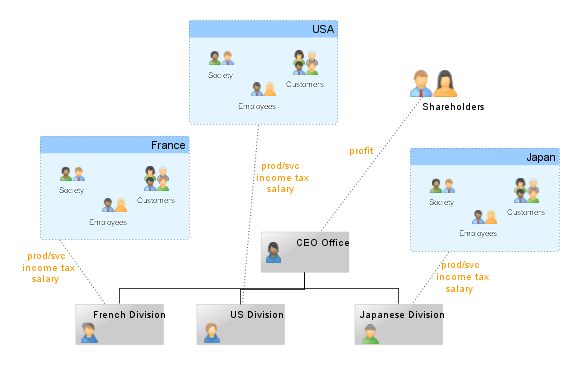
Each division was further divided using functional configuration as shown in Figure 4.2.
Divisional configuration can also be done by dividing a unit into regional, product/service, or market sector (customer) units (divisions).
Hybrid Configuration
At some point, the firm decided to create a specialized offshore software development unit to support all of Unsame's divisions. As well as the national divisions, the new unit was also reporting to the CEO Office, which resulted in the hybrid configuration shown in Figure 4.5.
Figure 4.5. Hybrid Configuration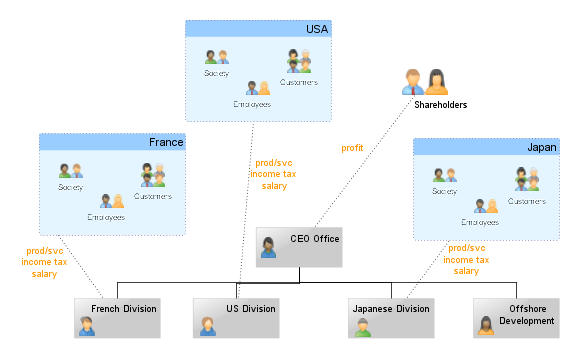
It's important to note that all units created as a result of decomposition (including the CEO Office) become the UOA first-class citizens and, therefore, must be implemented using unit oriented architecture. Each unit will have its own boundaries, run its own operations, and interact with other units by exchanging information.
Finally, it's important to understand that the correct implementation of a composite unit is one that creates a network. Figure 4.6 shows examples of both correct and incorrect implementations of a composite unit.
Figure 4.6. Compare implementations of a composite unit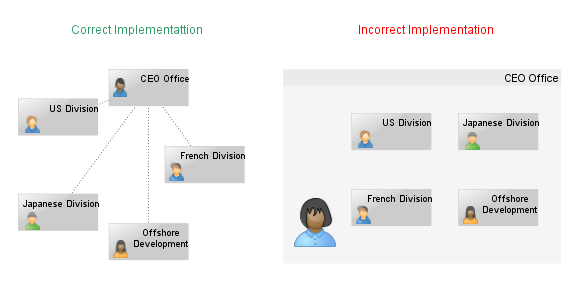
Key Points
UOA creates digital constructs that provide interactional and operational support to organizational units. An organizational unit is a social system, which represents a social technology phenomenon programmed to some purpose(s).
UOA views the organization as an implementation of the Composite design pattern with every node treated either as a Composite (control unit) or a Leaf (functional unit).
Unit software must be as comfortable to an organizational unit as a house is to a family, a space station to an astronaut crew, or a battle tank to a fighting crew.
Each unit must have a formal [software] boundary, which represents a contract between the unit and other entities inside and outside of the organization.
Each unit runs its own operations implemented as executable business processes. Every process in the organization is owned by exactly one unit. A unit might engage another unit or organization to perform a task within the context of the process it owns.
UOA places a special emphasis on control units, which today often consist of just one or a few people, have inadequate information support, and, therefore, have become the weakest links in modern organizations.
UOA uses Systems Thinking for defining the problem, Organization Design for configuring both an enterprise and a composite unit, SOA for constructing unit boundaries, EDA for inter-unit communication, BPM for defining unit operations, and Business Rules for governance.